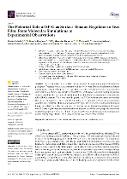The Potential Role of SP-G as Surface Tension Regulator in Tear Film: From Molecular Simulations to Experimental Observations

Author
Schicht, Martin
Kukulka, Mercedes
Li, Wenyue
Scheer, Aurelius
Garreis, Fabian
Jacobi, Christina
Paulsen, Friedrich
Bräuer, Lars
Publication date
2022Published in
International Journal of Molecular SciencesVolume / Issue
23 (10)ISBN / ISSN
ISSN: 1661-6596Metadata
Show full item recordCollections
This publication has a published version with DOI 10.3390/ijms23105783
Abstract
The ocular surface is in constant interaction with the environment and with numerous pathogens. Therefore, complex mechanisms such as a stable tear film and local immune defense mechanisms are required to protect the eye. This study describes the detection, characterization, and putative role of surfactant protein G (SP-G/SFTA2) with respect to wound healing and surface activity. Bioinformatic, biochemical, and immunological methods were combined to elucidate the role of SP-G in tear film. The results show the presence of SP-G in ocular surface tissues and tear film (TF). Increased expression of SP-G was demonstrated in TF of patients with dry eye disease (DED). Addition of recombinant SP-G in combination with lipids led to an accelerated wound healing of human corneal cells as well as to a reduction of TF surface tension. Molecular modeling of TF suggest that SP-G may regulate tear film surface tension and improve its stability through specific interactions with lipids components of the tear film. In conclusion, SP-G is an ocular surface protein with putative wound healing properties that can also reduce the surface tension of the tear film.
Keywords
tear film, surfactant protein, surface tension, ocular surface, dry eye
Permanent link
https://hdl.handle.net/20.500.14178/1824License
Full text of this result is licensed under: Creative Commons Uveďte původ 4.0 International







